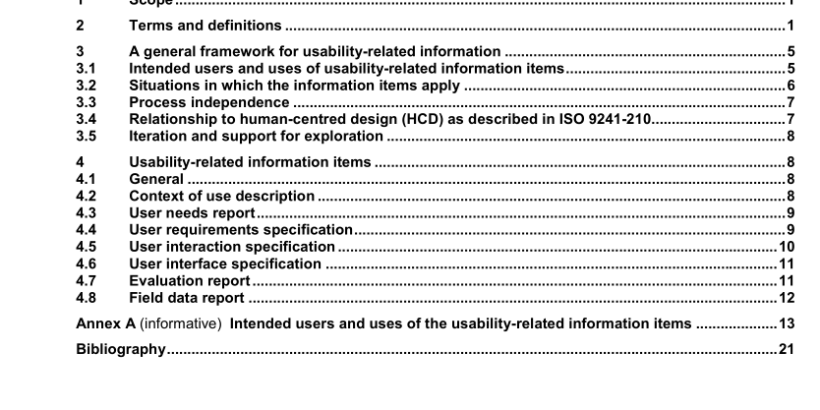ISO IEC TR 25060:2010 pdf download – Systems and software engineering — Systems and software product Quality Requirements and Evaluation (SQuaRE) — Common Industry Format (CIF) for usability: General framework for usability-related information
3.3 Process independence No formal process for processing the information items is given. Although the framework is not intended to prescribe an ordering of the information items, they are presented hierarchically from the general to the specific. For example the high-level user requirements are generally identified early in the process and as the process continues the user requirements become more specific. Usability related information items are not static thus the framework supports iteration as a principle of human-centred design.
3.4 Relationship to human-centred design (HCD) as described in ISO 9241-210 The goal of the human-centred design approach is to ensure that the development, acquisition and operation of an interactive system take account of the needs of the user as well as the needs of the developer and owner. A human-centred design approach takes account of the user’s interaction with the components of the system and with other stakeholders. Human-centred design processes allow developers and owners to analyse how the system will behave when it is in operation and to measure its usability. Human-centred design processes take account of context of use, i.e. the complete environment in which the interactive system will be used. Human-centred design processes address the total system within which software and hardware are components. ISO 9241-210 (previously ISO 13407) describes four linked human-centred design activities that take place during the design of any interactive system:
a) Understand and specify the context of use The characteristics of the users, tasks and the organizational technical and physical environment define the context in which the system is used. It is useful to gather and analyse information on the current context in order to understand and then specify the context that will apply in the future system.
b) Specify the user requirements User requirements are statements that provide the basis for design and evaluation of interactive systems to meet the user needs. The user needs are used as the basis for creating an explicit statement of user requirements in relation to the intended context of use and the business objectives of the system. The user requirements can include requirements for organizational changes, revised work styles and opportunities to combine products and services. If the proposed interactive system will impact organizational practice the development process will involve organizational stakeholders in the design process with the aim of optimizing both the organizational and technical systems.
c) Produce design solutions to meet these requirements Potential design solutions are produced by drawing on the description of the context of use, derived user requirements, the results of any baseline evaluations, the established state of the art in the application domain, and the experience and knowledge of the participants. These design solutions can lead to identifying further user requirements. The process involves designing the user experience, user tasks, interaction design and interface design; making the design solutions more concrete (using scenarios, simulations, prototypes, mock- ups etc); altering the design solutions based on user-centred evaluation and feedback; and communicating the design to those responsible for implementation. d) Evaluate User-centred evaluation includes assessing the usability, accessibility and user experience of the system, product or service. Evaluation starts at the earliest stages of the project, continues throughout development, and is used to provide feedback on actual use. User-centred evaluation can be used: to provide feedback on strengths and weaknesses of the design solution from the users perspective (in order to improve the design); to assess whether user and organizational objectives have been achieved which can include assessing conformity to international, national, local, corporate or statutory standards. Two widely used user-centred evaluation methods are expert evaluation using a checklist of usability and accessibility guidelines or requirements, and user testing with actual users. Real life use of a product, system or service is complex and even though standards can provide much useful guidance, user testing is an essential element of human-centred design.
